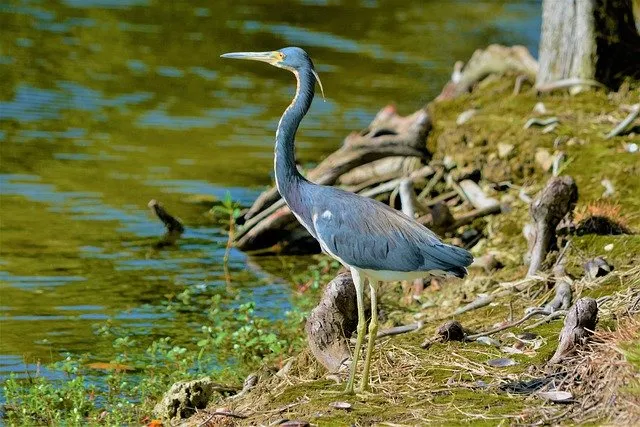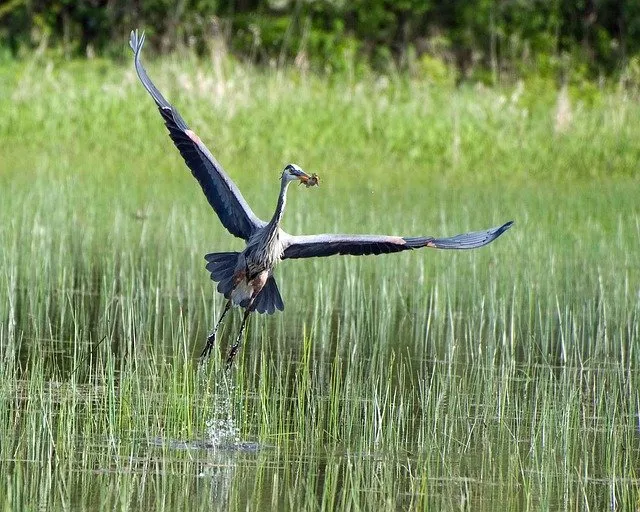As an Amazon Associate I earn from qualifying purchases.
Amidst the tranquil symphony of rustling leaves and babbling brooks, one enigmatic creature is a sentinel of serenity in wetland havens – the Great Blue Heron. With an aura of grace that seems to dance between water and sky, these magnificent birds have captured the hearts of nature enthusiasts and curious minds alike. But behind their elegant façade lies a question that beckons us into the heart of their world: “What do Great Blue Herons eat?”
Like culinary connoisseurs of the wilderness, these feathered fishermen boast a gastronomic palette that unravels a tale of adaptation, balance, and the captivating interplay between predator and prey. Embark on a fascinating journey as we unveil the secrets of the Great Blue Heron’s palate, exploring the delectable offerings that sustain their ethereal existence.
What Do Great Blue Herons Eat?
Nature’s vibrant tapestry is woven with many awe-inspiring creatures, each playing a unique role in maintaining the delicate balance of ecosystems. Among these magnificent beings is the Great Blue Heron, a majestic bird that is a testament to avian diversity’s beauty. Beyond its striking appearance and graceful demeanor, the Great Blue Heron has an intriguing culinary preference that underscores its role as a skilled predator and a vital component of wetland habitats.
1. Fish:
Great Blue Herons have earned the nickname “Fish Hawks” as proficient anglers due to their remarkable fishing skills. They wade through shallow waters, standing still as statues until an unsuspecting fish comes into view. With lightning-fast reflexes, they strike with sharp bills, impaling their prey. Fish form a substantial portion of their diet, encompassing a variety of species ranging from tiny minnows to larger fish like trout and bass.
2. Amphibians:
Frogs, toads, and salamanders also grace the heron’s menu. Their powerful bills allow them to grasp and swallow these slippery creatures quickly. Amphibians provide a nutritious alternative to fish and showcase the Great Blue Heron’s adaptability in seeking sustenance.
3. Invertebrates:
The heron’s culinary repertoire extends to invertebrates such as insects, crustaceans, and even small crustaceans like crabs and crayfish. They use their pointed bills to probe the mud and shallow waters for these delectable morsels, demonstrating their versatile feeding habits.
4. Small Mammals:
While their diet primarily consists of aquatic creatures, Great Blue Herons are not opposed to a terrestrial treat. They occasionally feast on small mammals like mice, voles, and gophers, showcasing their opportunistic nature when presented with the chance.
How Do Great Blue Herons Hunt?
Imagine a tranquil scene at the water’s edge: a Great Blue Heron stands tall and statuesque, its gaze fixed unwaveringly on the shimmering surface. This elegant avian predator is not just an emblem of grace; it’s a living embodiment of hunting finesse. The Great Blue Heron’s hunting technique is a symphony of patience, precision, and adaptability, finely honed through evolution to secure its place as a skilled aquatic hunter.
1. The Stealthy Approach:
The Great Blue Heron’s hunting ritual often begins with a patient wading into shallow waters. Its towering stature and seemingly slow movements mask an astute awareness of its surroundings. With each deliberate step, it moves closer to its unsuspecting prey.
2. The Stalking Stance:
Once within striking distance, the heron adopts a characteristic stalking stance that’s nothing short of a visual masterpiece. Its body tenses, its neck coils like a spring, and its eyes lock onto its quarry. The world seems to hold its breath as the heron becomes a living sculpture of anticipation.
3. The Lightning Strike:
In a breathtaking moment in the blink of an eye, the heron strikes with unparalleled swiftness. Its long, pointed bill darts downward, piercing the water’s surface like a weapon. The element of surprise, coupled with the heron’s quick reflexes, ensures that its prey has little time to react.
4. The Catch and Consume:
The heron’s bill acts as a spear and a pair of tweezers. Depending on its target, it might impale fish directly or use its precision to pluck small aquatic creatures from the water. With a flick of its head, the heron deftly maneuvers its catch into an optimal position for swallowing.
5. The Importance of Adaptation:
While the Great Blue Heron’s hunting technique may appear uniform, it is remarkably adaptable. Depending on prey availability and the water’s depth, the heron might employ varying strategies. It may use a more cautious approach in shallower waters, while in deeper waters, it might rely on swift strikes to seize fish near the surface.
6. The Dance of Balance:
The heron’s hunting prowess extends beyond its physical capabilities; it’s also a testament to the delicate balance it maintains in the ecosystem. By preying on fish, amphibians, and invertebrates, the heron helps control populations, preventing any single species from dominating. This harmonious equilibrium ensures the health of the wetland habitats it calls home.
How Does The Great Blue Heron Impact Our Ecosystem?
In the intricate dance of nature, every participant plays a vital role in shaping the delicate balance that sustains our planet’s diversity. Among these participants, the Great Blue Heron emerges as a guardian of equilibrium, profoundly impacting ecosystems beyond its graceful presence. From the lush wetlands to the rippling waters, the heron’s influence weaves through the fabric of nature, fostering health, diversity, and harmony.
1. Population Control:
The Great Blue Heron’s primary diet consists of fish, amphibians, and invertebrates. This dietary diversity is more than just a gastronomic choice; it’s a crucial mechanism for population control. By preying upon these various species, the heron helps regulate their numbers. This, in turn, prevents the overpopulation of certain species that could disrupt the ecosystem’s delicate balance. The heron’s role as a top predator helps maintain biodiversity and supports the health of its habitat.
2. Wetland Health:
Wetlands are often called the “Earth’s kidneys” because they are vital in purifying water and maintaining water quality. The presence of Great Blue Herons in wetland habitats is beneficial for the overall health of these environments. Their presence helps keep the wetland ecosystem in check, preserving the delicate balance of flora and fauna. In addition, the heron’s foraging activities help prevent the proliferation of certain aquatic species that might otherwise dominate the environment.
3. Trophic Cascade Effects:
The Great Blue Heron’s impact extends beyond its immediate prey. When heron populations thrive, the resulting decrease in prey populations can trigger a trophic cascade. In this ecological phenomenon, changes in one species’ population ripple through the entire food web as fish populations are controlled by herons; the smaller aquatic organisms that these fish feed on can also experience changes in their numbers. This cascading effect underscores the interconnectedness of all species within an ecosystem.
4. Habitat Preservation:
The Great Blue Heron’s presence can also indirectly contribute to habitat preservation. As these birds rely on wetlands for food and shelter, their well-being becomes intertwined with the health of these ecosystems. This, in turn, encourages conservation efforts to protect wetland habitats from degradation, pollution, and encroachment. By safeguarding the heron’s habitat, we inadvertently preserve many other species that survive on wetlands.
5. Inspiration for Conservation:
Beyond its ecological impact, the Great Blue Heron is an ambassador for wetland habitats’ beauty and importance. Its striking appearance and distinctive behavior captivate the imagination of nature enthusiasts and the general public alike. This fascination can foster a deeper appreciation for the natural world and inspire individuals to take action in conserving and restoring wetland ecosystems.
Final Words
In the captivating wetlands, the Great Blue Heron’s role as a skilled predator and ecological influencer is awe-inspiring and essential. Unveiling the question of “what do great blue herons eat?” has unraveled a tale of patient hunting, adaptable strategies, and far-reaching impacts. From controlling populations to maintaining wetland health, these majestic birds are guardians of balance in our ecosystems. Their presence is a reminder that every species, no matter how small, plays a crucial part in nature’s intricate web. As we continue to appreciate their grace, let’s also recognize our shared responsibility in nurturing the habitats that sustain them and the diverse life they touch.
You can also read:
1.What Do Gray Wolves Eat? Unveiling the Culinary Adventures
2.What Do Russian Tortoises Eat? A Guide to Their Nutritious Diet
3.What Do Red-Winged Blackbirds Eat? Exploring the Diverse Diet
4.What Do Red Squirrels Eat? Red Squirrels’ Culinary Adventures
Amazon and the Amazon logo are trademarks of Amazon.com, Inc, or its affiliates.



